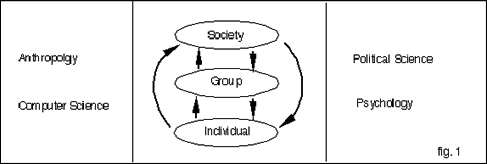

|
Home |
Executive Summary (original proposal)
Scott
Atran, University of Michigan & CNRS, Anthropology Consultant:
The spectrum of our expertise is critical to the success of our proposal. We will use a multi-prong, interdisciplinary attack. First, the field data available on the effects of cultural change on belief dynamics and behavior will be brought to the attention of the collaborating modelers, each expert in quite different types of computational models. These include probabilistic models, Bayes nets, agent-based networks, graphical models, causal and analogical models, and game-theoretic models. This range of models provides us with different representational frameworks appropriate for different levels of analysis, and subsequently, for the integration of models across the individual, group and social levels. In parallel, we will engage in further field studies to increase our database. Thirdly, we use a VR microworld in the laboratory to probe the more universal factors underlying trust, cooperation, leadership in adversarial group decision-making. To achieve our objectives, we have an aggressive plan that capitalizes on collaborations already in place, as well as creating new collaborations among modelers and experimentalists. At least eight collaborations are proposed, as listed in Section VI. Considering the interdisciplinary breadth of our team (Computer science, political science, anthropology, cognitive science, psychology, public policy, education), it is critical that face-to-face meetings of the group take place early and often, to enhance the understanding each other's perspectives, semantics and mind-set. The first meeting will occur in mid-summer '05. At the second meeting, six months later, pilot experiments, programs and preliminary results of models will be presented. These semi-annual meetings will be supplemented by meetings of pairs of collaborators. This aggressive schedule is designed to lead to informative pointers in the development of successful models even within the first year. Because of accessibility, our initial focus will be on modeling field studies data on behaviors and cultural shifts observed in Guatemalian and Native Indian societies. A secondary focus will be studies of terrorist networks and the belief revisions underlying their dynamics.
The outcome of this research, if successful, will be the first integrated computational models of how individual beliefs can influence group decision-making, how groups begin to coalesce into larger entities that lead to cultural shifts, and how these in turn lead to revisions in individual beliefs. Our models will provide predictive tools that can advance adversarial decision-making. For example, they will (1) identify key variables in social networks within different cultures that can be manipulated to revise beliefs; (2) show how social networks may be shattered or made to cohere through cultural shifts or external pressures; (3) show analogies and differences between cultural mind-sets that will provide better perspectives on how societies in different cultures will react to new pressures or to institutional change, and (4) give insights into how trust and belief revision can impact the effectiveness group decision-making.
|
|
|
